
Commence your round with this sophisticated dogleg-left Par 5, elegantly contoured around a prominent Pecan tree. This hole immediately challenges your precision and shot-making prowess. From the tee box, it necessitates a draw over a modest tree situated approximately 150 yards from the commencement point. Should this shot not be within your repertoire, it is advisable for players to opt for a 3-wood or an iron, thereby circumventing the hazards and out-of-bounds areas flanking both sides of the fairway. A well-executed drive may position players to reach the green in two, utilizing either a wood or a mid to long iron. However, with bunkers strategically placed at the front left and back right, securing a birdie is by no means a straightforward task. The green’s gradient is sufficiently challenging to test even the most adept putters, making both birdie and par commendable achievements on this hole.

This hole presents a sophisticated dogleg left, requiring both impeccable ball striking and astute course strategy. To successfully navigate over the pond from the tee, one must exhibit proficiency with long irons or fairway woods, aiming to position the tee shot centrally within the constricted fairway. Shots that are excessively long or veer too far to the right risk either going out of bounds or being obstructed from the green by recently planted saplings. A venerable and imposing Pecan tree stands sentinel on the left, often deflecting balls back into the pond. The elevated green, divided into two distinct tiers, is fronted by a sizable bunker. It would be prudent to select an additional club for this approach.
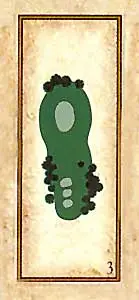
The inaugural Par 3, spanning 155 yards, introduces players to the forthcoming topographical variations. Upon first encounter, the captivating aesthetics of this hole might divert one’s attention towards capturing its beauty rather than focusing on the golf shot. The green, nestled significantly below the tee, is framed by majestic pines, live oaks, and a striking rock cliff positioned just beyond the pin. Players are advised to select a club with less distance to account for the elevation differential, but caution is required to not underestimate due to the pronounced slope at the forefront. It’s imperative to steer clear of the extended right section, as balls landing there are prone to ricochet off the hill, potentially leading to out-of-bounds. The left perimeter is marginally more lenient, with a protective embankment situated behind the green; however, further left lies a lateral hazard. Notably, the green’s contour tends to influence putts to gravitate towards the river, often more than anticipated.
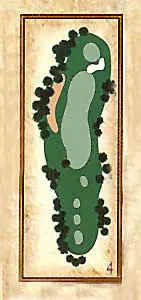
The #1 handicap hole requires length and accuracy from the tee and the approach. This par 4 is the longest on the course at 403 yards and plays up hill the entire way. OB is tight to the fairway on the right. Just a few yards off the fairway left, a hill directs balls down into a lateral hazard. Unless you can hit driver over 280, you will probably be left with a blind approach to an unforgiving green that’s protected by a bunker at the front right. During dry times a run-up shot is the only way to get the ball close to the pin, and is a pretty good play the rest of the year. This green slopes just as much as all the others which means even a four footer can break two feet. Par here is like a birdie on any other hole.

A short and sometimes drivable uphill par 4. Your tee shot here is from a shoot of trees up the hill where the hole turns to the left. The best position to approach the green is from the right side of the fairway and far enough away that you can spin the ball. The approach shot should be well thought out before committing to one play or another. Shots that fly in and don’t have backspin will go over the green into the back bunker or down to the 6th tee. Any shots that are short will stay short and getting up and down will be difficult. Making a par here is tough. It requires a precise 2nd shot to the green.

Local knowledge plays a vital role on this beautiful and challenging Par 4. This hole can be played two ways. The conservative approach is a mid to long iron from the tee hit to the right side of the fairway leaving a full short iron over the cliff to the green, usually a blind shot. The second method is hitting 3 wood or driver to the corner and being left with a half to three-quarter wedge with little or no backspin. It’s best to land this shot short of the pin and let it run up to the hole. A two putt on this roller coaster green that slopes toward the Colorado is always difficult.

This Par 3 will demand a smart play combined with a well struck shot. A player that knows his game and has a shot that he can count on has a real advantage here because of the small margin for error. The Colorado lurks a few paces from the green on the left side, out of bounds is half that on the right and with the hole measuring 200 yards from the blue tees, players tend to lock up and hit some unusual shots. The result is a lot of penalty strokes and some high scores. Balls hit long or short leave a tough up and down. Par here is an excellent score.
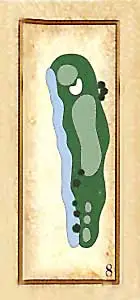
A straight and tough Par 4 (390 yards) with plenty of hazards to test your nerves. The layout here is similar to hole #7 (river left and out of bounds right) except here, you need to hit driver off the tee. You can take your pick; aim left toward the river and hit a fade, or aim right toward the road and hit a draw. This will allow you use the entire 20 yard wide fairway. Avoid missing the green left on the approach as those shots will feed into the river. Your approach shot over the right front bunker to the center of the green should allow for a decent look at birdie.

A dogleg right Par 5 that entices players to attempt reaching it in two but yields few birdies and even fewer eagles. There is a distinct corner on this hole created by some tall oaks and the tee shot should definitely favor the left side in order to have any chance at the green in two. Even with an opening to the green a great shot is required to first reach the green, then holding it. Once on this relatively flat green, players should have a pretty good chance to make their putt to finish the front nine.
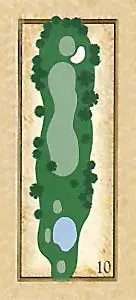
A tough par 5 that requires some shot-making skills to have a chance at a birdie or par. The tee shot must be accurate as OB come into play on the left and right. The center or left side of the fairway is best for players who want to try for the green in two. Beware to any shot hit left toward the left edge of the green as it may well bounce hard left into the hazard. The prudent 2nd shot approach is 80 to 100 yards from the green. The 3rd shot approach is to the right center over the large greenside bunker guarding the front right portion of this very undulating green that slopes severely toward the Colorado River. A birdie is very possible as is an eight.
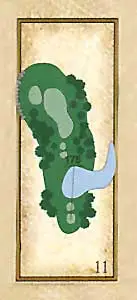
A short dogleg left par 4 that requires a tee shot with little room for error. The most intimidating tee shot on the course for most players requires a carry of 170 over a deep ravine and lake avoiding a right side bunker. After surviving that, players are required to approach the green with cautious precision. The left and back of this small green presents another ravine and the most scenic view on the golf course. Playing to the right is not really an option either because of the slope down to the next tee where many balls disappear into the unknown. Once a player reaches this relatively flat green one can enjoy the views and probably make a putt or two.

This signature Par 3 is the most recognizable hole and for good reason. The green is nearly 75 feet below the tee and surrounded by the tallest trees in Texas. First time players can pick just about any club and hope they guess the right one. The hole measures 170 yards but won’t play nearly that long because of the change in elevation. The green slopes severely from back to front which will help you on the tee shot but makes your 2nd, 3rd, 4th, or even 5th shot very difficult. You will definitely want to leave your tee shot below the cup, hopefully on the green
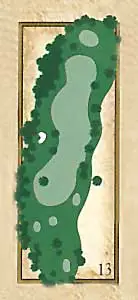
A tight par 5 that runs like a tree lined roller coaster from tee to green. After a blind tee shot to a narrow fairway that slopes right to left, your next shot isn’t any easier. A player must hit another blind shot to lay up, or go for the green if you have the distance. Although this green has no bunkers it is small with severe slopes that will challenge golfers of all levels.
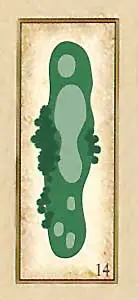
A short straight-forward par 4 with the entire hole in plain view. Being only 346 yards from the white tees and wide open, many players expect to make birdie or par here, until they get to the green. This green is not only small but slopes deceivingly toward the river and causes putts to break much more than appears. With a pitching wedge or sand wedge for your approach shot, a player would be wise to keep the ball on the right half of the green, below the cup.
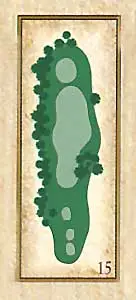
This somewhat short par 4 (364 yards) doglegs slightly to the left and rises up to an elevated green that can be hard to hold. This hole is another one of the few on the course where you can see the fairway and the green. With a straight drive to the corner of the dogleg, a wedge or 9 iron is all that is needed to hit this green. Most players will want to either hit the ball a little harder or use one more club to reach this elevated green.

A long Par 3 that drops nearly 50 feet from tee to green. This Par 3 can leave a golfer questioning his club selection because of the change in elevation and the mysterious wind above the tree line. On the right side of the green a hill slopes off almost 20 feet into a flat area. Seeing only the top of the flag stick from the flat makes getting up and down difficult. Players will want to favor the left side and be content with par.

The toughest Par 3 on the course. This hole plays as the #4 handicap hole and for good reason. Prevailing winds makes this 210 yard hole play closer to 235 and the green is small. Two bunkers, one on the front right and one in the back left, protect this undulating green. If those hazards aren’t enough to frustrate you then the OB left and Colorado River on the right surely will test your patience. The green looks fairly level, but most putts break toward the river.

Finish your round with a somewhat short par 5 that is very reachable from the white tees but will take two good shots from the blue. The key to reaching this hole is keeping the tee shot on the upper level of this two-tiered fairway without going into the street and out of bounds. From the upper left fairway the ball can be hit across the mounds on the left, making it a shorter hole. Two bunkers guard the left front of the green. If you’re not in the mood to go for it, a medium iron is all it takes to lay up 80-100 yards out. Measure your approach carefully because the two levels on the green can be deceiving. Eagle here is exceptional, birdies are possible and par is always a good score and a good way to finish your round.